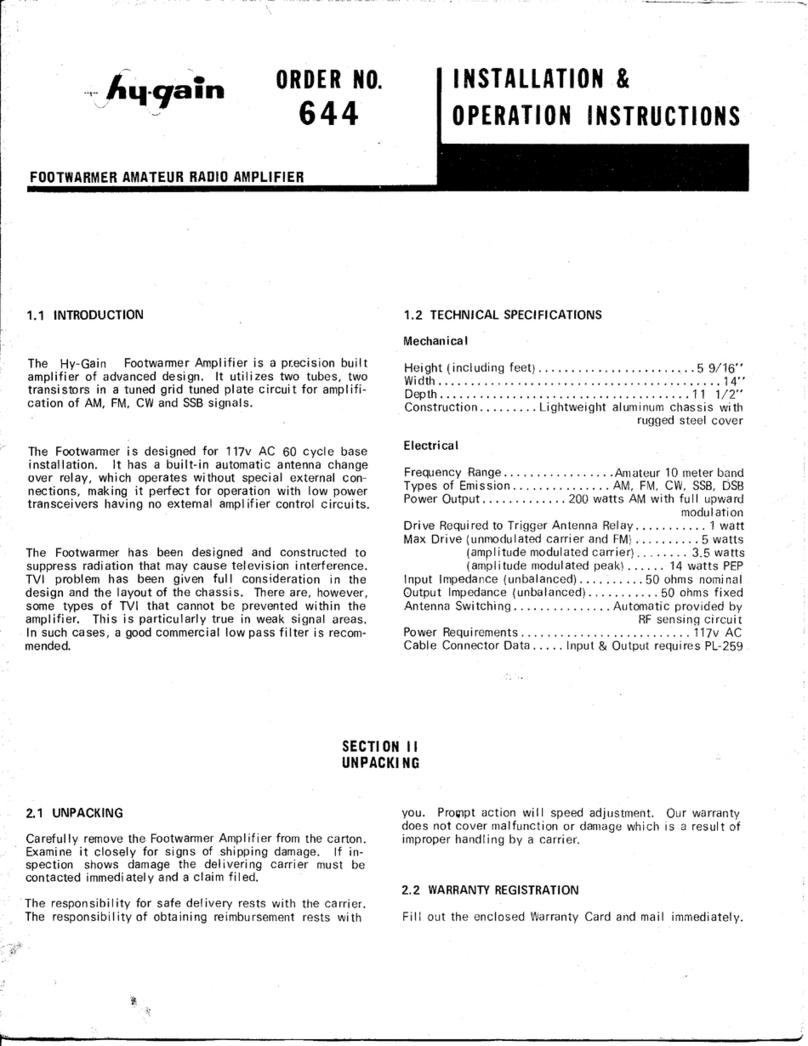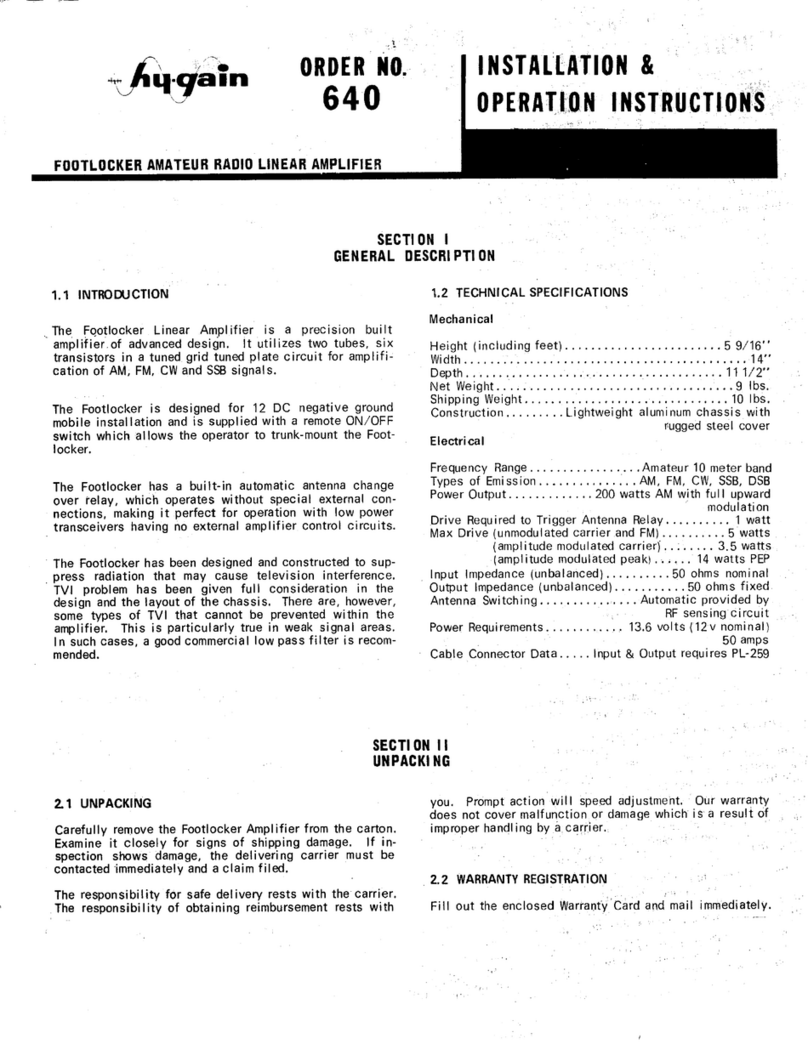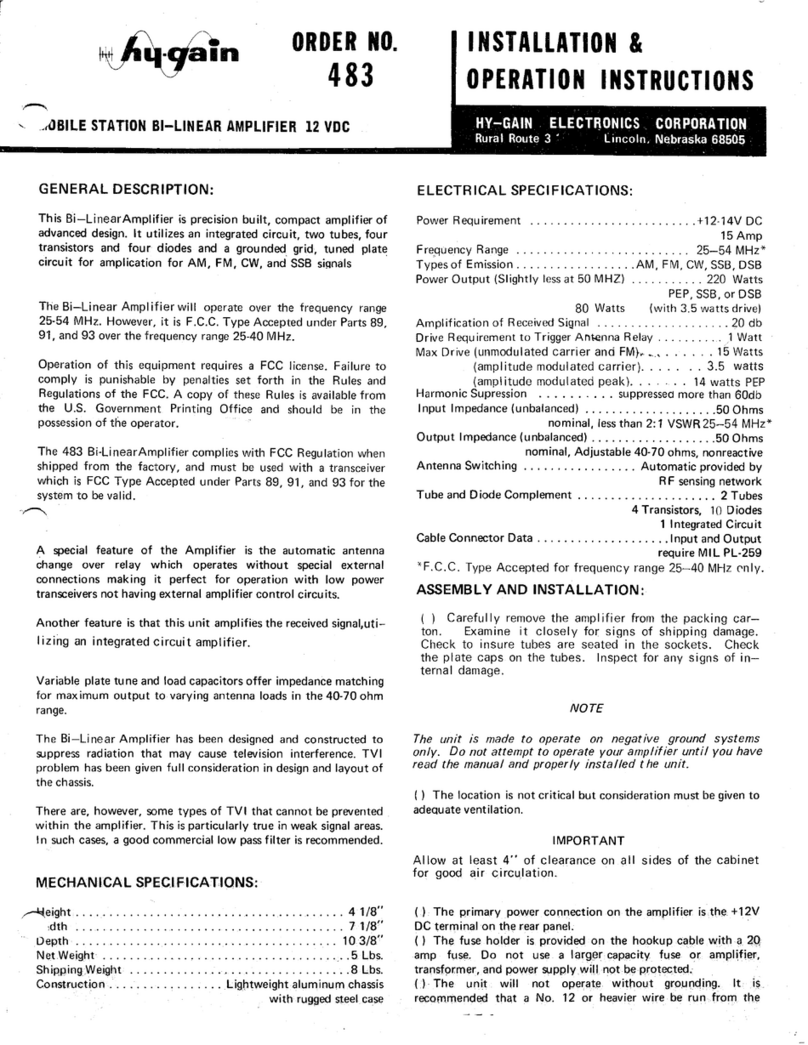
ON-OFF Switch Controls 120V AC power to amplifier.
AM-FM
&
SSBSwitch Adjust delay constant of automatic
antenna relay.
XMT-Standby Switch Activates the automatic antenna
relay circu it,
also supplies power to the receive amplifier circuit.
Receiver Amplifier ON-OFF Switch .... Activates the integrated
circuit receive amplifier.
r\lOTE: Receive amplifier will only operate when
the XMT-Standby switch is in the XMT position.
RED Indicator Light Visual indication of
applied 115 V AC power.
Output Meter Visual indication of
relative RF power autput.
Tune Control Adjusts resonant frequency
of amplifier.
Load Control Adjusts coupling of
output circu it to.antenna.
WHEN THE AMPLIFIER IS USED IN THE BUSI NESSBAND, AD-
JUSTMENTS MUST BE MADE ONLY BY A FCC LICENSED
TECHNICIAN.
The 482 Bi-LinearAmplifier is factory adjusted for the range
25-32 MHz. Operation over the range 32-40 MHz requires a
change in the number of turns in L1 (RF Tank Coil). A shorting
tap is placed on the end of the coil, from the left-hand side as
viewed from the front panel (seefig. 2) to the first turn, counting
from the left side.
This Amplifier must be used with a transmitter or transceiver
capable of at least one watt output.
Remove Controls cover for tuning and loadinq.
Install knobs supplied in separate parts pack. Fully mesh
both the Tune and Load Capacitors, then insta II the smaII
knob on the Tune and the big knoll on the Load capacitor
shaft, insuring that the marking on the knobs are horizontal
and pointing to the left when viewed from the front.
First place the function switch in the AM:FM position. Set the
tune control in accordance with the warning on page 3 of the
manual. The load control should be positioned so that the
capacitor is fully meshed,
Now push the ON-Off switch to ON. The red visual indicator light
will light.
After warm-up, push the XMT-Standby to XMT. This will
energize the automatic antenna relay control circuitry, and
provide power for the integrated circu it receive amplifier.
Apply drive power by keying the exciter (transceiver)
microphone and quickly adjust the tune control for maximum
deflection on the output meter. Remove drive power after
adjustment.
NOTE
Do not apply drive power for more than five seconds without
adjusting the tune control or damage to the tubes can result.
Reapply drive power and advance (clockwise) the load control,
note the increase in deflection of the output meter. Adjust the
load control for maximum output. Remove drive power.
Readjustment of the tuning and loading controls several
times will produce maximum output.
To provide for the extra power contained in the AM signal
modulation it is necessary to overcouple the output circuit.
This is necessaryto insure an undistorted output with a minimum
of adjacent channel bleed ing (spatter).
Reapply drive power and advance the load control until the
output meter drops perceptably, (about 15 per cent more
rotation). Readjust the tune control for maximum output. The
output circuit is now overcoupled .
If a relative power output indicator is available (SWR bridge on
forward, etc.) the output signal can be quickly checked to insure
upward modulation. If the meter does not flick upward on
voice peaks, the load control is improperly set (or the exciter is
not capable of 100 per cent modulation or may have downward
modulation ). Also seen on output meter.
Automatic antenna change over and amplifier operation is
provided for by a special transistorized input sensing circ~
Should you desire to hold the amplifier in a ready condit'
but not use it until needed, simply place the XMT-Standby in
tM
standby position. The sensing circuit will be disabled and the
antenna connected to the exciter (transceiver) at all times.
IMPORTANT
With the XMT-Standby switch in the standby POSition, the
REC AMP switch should be in the OFF position. This will
prevent the receive ampIifier loadi ng the transceiver output.
The amplifier istuned for FM service in a manner identical to AM
except the load and tune controls are set for maximum output.
Place the function switch in the SSB position. This will connect a
delay circu it to the automatic relay control and extend the
drop-out approximately one second. This will prevent relay
chattering and erratic operation.
If the exciter (transceiver) is capable of carrier output equal to
the peak power of the voice SSBor DSB signal, simply adjust the
tune and load controls for maximum deflection of the output
meter while applying carrier.
If the exciter (transceiver) cannot ~pply a carrier equal t0l \
peak power of the voice SSB or DSB signal then the tune
load controls must be set for maximum output while modulati~:
In this case, a modulation envelope indicator (monitor scope) is
the most reliable method for adjustmel]t of the amplifier.































